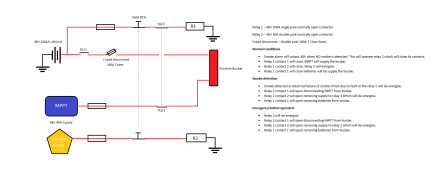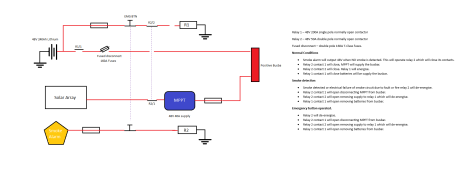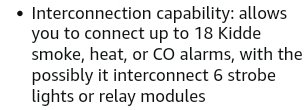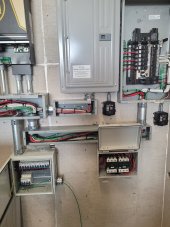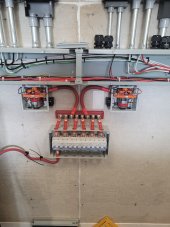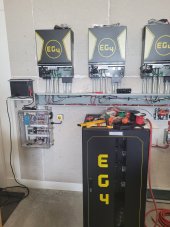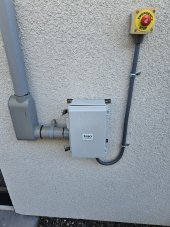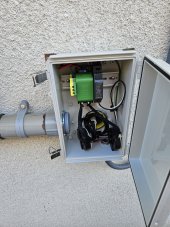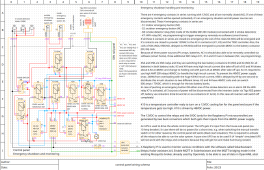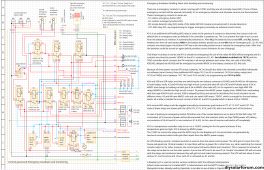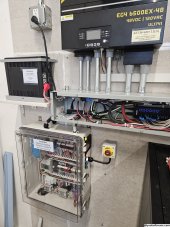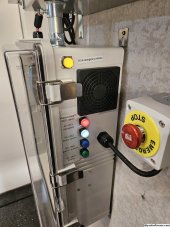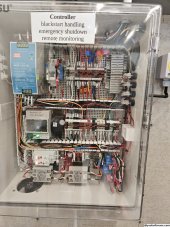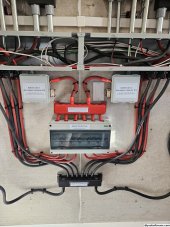I've built a controller for monitoring and emergency shutdown. The emergency shutdown will occur in case of pushing either one of the two "emergency stop" buttons (one inside and one outside of the house) or one of
3 Kidde smoke detectors are triggered via
Kidde SM120X Interconnect relay which are placed over the parallel AIO inverters or via remote controlled smart relay (the remote relays are integrated in my existing smart home system to be able to also shtudown the system by other type of rules/conditions, e.g. a camera may detect smoke over the inverters, etc.). The emergency shutdown circuit is build just with some relays (no microcontroller) and the monitoring is done via SolarAssistant with a Raspberry Pi. I put everything together in a DIN rail enclosure and also installed a fan with temperature controller for the DIN rail enclosure.
Some implementation details and points:
In my case, the EG4-6500EX AOI inverters, are only doing a real "cold" shutdown if all energy sources will be disconnected (this is what I want to achieve in case of emergency/fire).
For battery disconnect of my two battery racks, I' using two
48V/600A golf cart contactors one for each battery rack.
For AC-in disconnect of my six EG4-6500EX inverters, I'm using two
120V/110A 3 pole contactors one for each phase.
For PV disconnect (Rapid Shutdown System) of my 40 PV panels, I'm using 20 of the
Tigo TS4-A-2F remote switches with one
RSS-Transmitter.
The PVRSS is by far the most costly part. But in some areas it's already a requirement to integrate a PVRSS in a PV system to protect the life of the first responders against high PV voltage. I live in Arizona and here a PVRSS is not yet a requirement, because the state still follows the "old" NEC2008 standard. But the current
NEC2017 standard requires it already!
If you may find high voltage PV contactors you may also be able to make the PV disconnect simpler - but in this case it will not be NEC2017 compliant.
It took me a while to make the decision to go for the PVRSS (even it's not yet a requirement here - but soon) for the PV disconnect and spend this huge extra amount of money. But after considering things like permit, inspection, federal incentives, house fire insurance, resell value of the house, etc. I've decided to go with the complete PVRSS solution for PV disconnect part.
The left picture was the circuit while in building and testing phase. On the bottom left you can see the two 600A battery contactors and on the bottom right the two 3-pole AC-in contactors. The other pictures shows how they are mounted and placed on the wall.
View attachment 157773View attachment 157774View attachment 157775
View attachment 157776View attachment 157778View attachment 157779
The shutdown controller and monitoring circuit is now running for about 4 month without issues - after correcting some initial problems. Btw. The system is not yet finished. The Inverters, AC-in charger, batteries are working - but PV panels are not yet installed because of time constraints and heat in Arizona. But I've done some PVRSS tests with some of the panels just to check if this also works and it does. So far I've charged the batteries via grid and will be able to drive the whole house from batteries/inverters in case of grid failure - like an UPS.
This is the final schematic:
View attachment 157781
